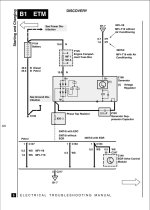Some time in the last couple days my charging system stopped...charging. Everything else is working, starter, ignition, lights. etc.. Indeed, per Lucas POD SOP, NO warning lights have illuminated to indicate a battery/charge problem at all  The only tell when the tach and speedo started doing their low-voltage dance this morning when I tapped the brakes. Alfred left me high and dry at the local coffeeshop. I got it jumped and made the short trip home.
The only tell when the tach and speedo started doing their low-voltage dance this morning when I tapped the brakes. Alfred left me high and dry at the local coffeeshop. I got it jumped and made the short trip home.
Here is the lay of the land:
My questions, beyond "any else already solve this problem" are:
Related to this maybe:
https://discoweb.org/index.php?threads/1996-discovery-new-battery-wont-start.95464/
Please let me know.
Here is the lay of the land:
- The battery was replaced less than a month ago.
- The battery dropped down to 9.75v.
- I pulled the positive cable while the engine was running.. to do the old fashioned alt-check... the engine did something odd:
- attempt 1 (battery @9.75v): the engine immediately died: Making me immediately think the alternator was bad (it *IS* the original)
- attempt 2 (battery externally charged, via trickle-charger, @11.6v): engine started and ran, when I pulled the positive cable.. the engine continued to run for about four (4) seconds and then sputtered (and almost died).. i quickly put the lug back onto the + post and the engine recovered.
- I tried this a few times; the engine continues to run for a few seconds (high idle speed only) and then sputters and dies.
- I swapped the alternator with a known-good unit but still: no charging.
- I installed new headlight lamps a couple (remarkably coincidental) days ago.
My questions, beyond "any else already solve this problem" are:
- Is there a fusible link that directly stops the alternator from charging but does not impact battery voltage from energizing the rest of the system?
- Is there something else I need to check? e.g.: engine ground strap, some obscure (or not so obscure) relay, fuse, fusible link, or ground cable that would cause the alternator to stop working but leave everything else (engine, lights, etc) alone?
- Can anyone explain how the engine would continue running for a few seconds before dying, when the battery terminal is disconnected?
Related to this maybe:
https://discoweb.org/index.php?threads/1996-discovery-new-battery-wont-start.95464/
Please let me know.
Last edited:
